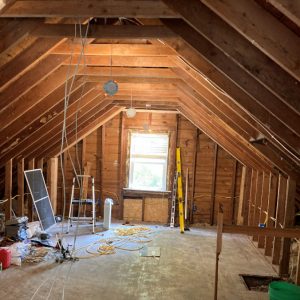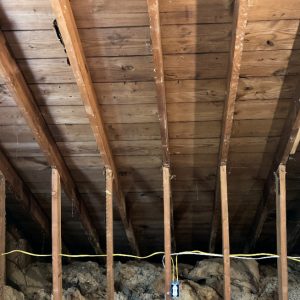Which is best for insulating a cape?
I am in the process of gutting and insulating the upstairs of a cape that has no soffit venting in climate zone 5. Prior to gutting, the ceiling was made of small ceiling tiles, that was covering with R-11 (at best) faced fiberglass which was stapled to the rafters leaving a ~2” air gap between the roof deck. After removing the fiberglass, the roof deck looked to be in pretty good shape.
As I now plan to have spray foam insulation installed, I am wondering what application of closed cell spray foam would be best. Would it be best to spray the entire roof deck, from the ridge to the eves? Or would it be a better option to spray from the ridge to the knee wall, and then insulating the knee wall with R-15. Originally I was going to spray the whole roof deck, but I have become aware of the need for these old houses with leaky basements to be able to breath. I am hoping that leaving the roof deck beyond the knee walls without spray foam will allow it to breathe better and avoid some potential humidity issues and it would also cut down the spray foam bill. Each side beyond the knee walls currently has a single roof vent and the floor joist are covered with ~12” of loose fill cellulous.
Essentially, I am wondering which of the two scenarios outlined in the following link is better: https://www.finehomebuilding.com/2016/03/06/two-ways-to-insulate-an-old-cape
My current opinion leads me to the following pro/con list:
Scenario 1: Insulate entire roof deck
- Pros:
- Lower chance of air leakage
- Prevent roof deck moisture problems
- Cons:
- More Expensive
- Larger conditioned space volume
- Potential living space humidity issues
Scenario 2: Insulate about living area w/ fiberglass on knee walls
- Pros:
- Lower Cost
- Allow humidity to escape outside of living space
- Smaller conditioned area
- Cons:
- Potential air leakage
- Unconditioned temps beyond knee wall























Replies
I finished my own place four years ago and I chose to fully spray the entire roof. Remember with closed cell it's not just about air vapor it's also about air sealing the space and closed cell foam does an excellent job of air sealing, that the fiber batts never can do.
Also remember that ice dams are caused by the heat from the interior space melting the snow on the roof. If you want to avoid ice dams foam the whole roof. Aren't you using the knee wall space for stroage?
I renovated a cape in zone 5, as did a neighbor. He went with spray foam on the whole interior, walls included, but the basement had already been well sealed against moisture.
I sealed moisture in the basement from the house by waterproofing the basement ceiling and installing good drainage in the floor.
It would be a serious mistake to think that the knee wall could serve as a way to release excess indoor humidity. What you will get is massive condensation inside the wall and soon after rot. Spray foam the entire roof, and study up on how to do the walls.Green Building Advisor has a lot of info on the subject of handling indoor moisture. All I can add is get a foam contractor who is really good attending to details.